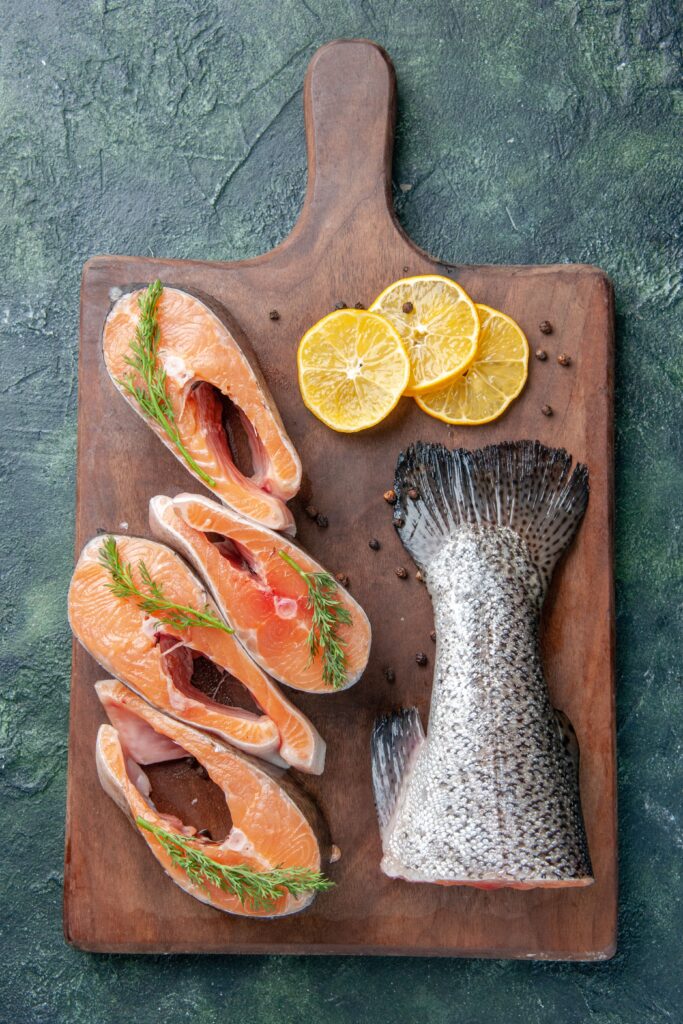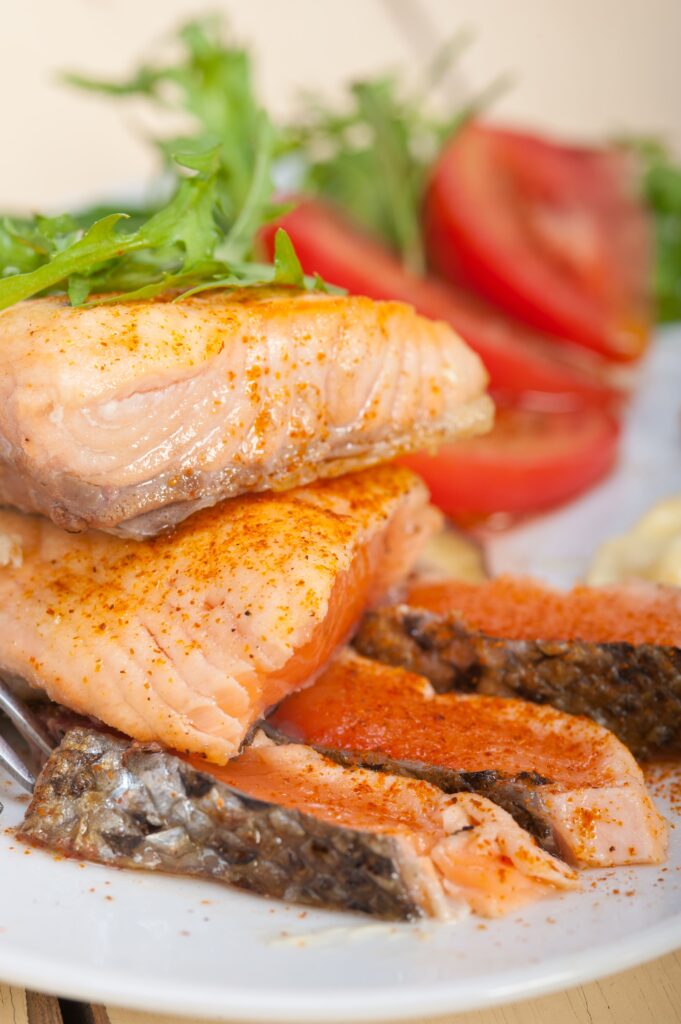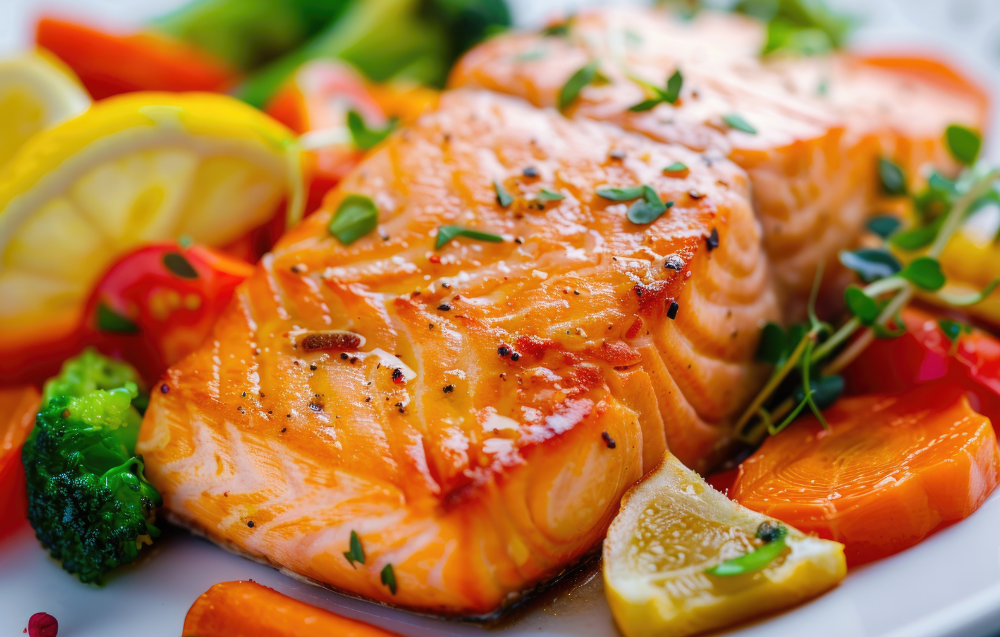Pink salmon, often overshadowed by its more famous relatives like sockeye and king salmon, deserves its time in the spotlight. This incredible fish, also known as humpback salmon (because of the hump males develop during spawning), has a fascinating life cycle, nutritional benefits, and an essential role in the ecosystem. Curious to know more? Let’s dive into the world of this salmon!
Introduction to Pink Salmon
If you’ve ever been curious about what makes pink salmon unique, you’re in the right place. It’s not just another fish in the sea—it’s a vital species that bridges the gap between human nutrition and marine ecosystems.
What Is Pink Salmon?
Pink salmon (Oncorhynchus gorbuscha) is the smallest of the Pacific salmon species. Typically weighing between 3 to 5 pounds, these silvery fish are known for their mild flavor and tender texture. Found primarily in the northern Pacific Ocean, this salmon migrate into freshwater rivers and streams to spawn, a journey that is both fascinating and crucial for their survival.
This salmon thrive in colder waters and have a distinctive two-year life cycle, which means every year a new generation begins its journey, ensuring the species remains abundant.

Looking for a great side to complement this salmon? A loaf of artisan Italian bread could be the perfect pairing.
Importance of Pink Salmon in the Ecosystem
Why is pink salmon so important? Think of them as nature’s multitaskers. These fish don’t just sustain other marine animals like bears, birds, and seals—they also fertilize riverbeds with their decomposing bodies post-spawning. This process nourishes aquatic plants, benefiting future generations of fish.
“Pink salmon are the unsung heroes of their ecosystems, contributing more than meets the eye,” explains a marine biologist. Without them, many rivers and their inhabitants would struggle to thrive.
For a recipe twist, consider exploring the spicy flavors in Cajun shrimp pasta and adapting it for salmon.
Pink Salmon vs. Other Salmon Species: Key Differences
So, how does pink salmon stack up against its cousins? While sockeye is prized for its vibrant red flesh and chinook is revered for its size, this salmon has its charm. It’s more affordable, widely available, and easier to cook, making it perfect for families and budget-conscious shoppers.
But it’s not all about price. Pink salmon is also lower in fat compared to other species, making it a great choice if you’re looking for a lighter, healthier meal.
Cooking tip: When baking salmon, choosing the right cookware is key. Learn more about what pan is best for the job.
The Life Cycle of Pink Salmon
If you think the journey of pink salmon is like a quick road trip, think again. It’s more of an epic adventure—filled with challenges, dangers, and a satisfying conclusion.
Spawning and Reproduction Patterns
Pink salmon begin their lives in freshwater streams and rivers. Female salmon dig shallow nests called “redds” to lay their eggs, while males compete fiercely for the chance to fertilize them. Once spawning is complete, both males and females die, leaving behind a nutrient-rich legacy.
This might sound grim, but it’s nature’s way of balancing the ecosystem. Their bodies nourish plants, insects, and even other fish.
Migration Routes and Habitats
After hatching, juvenile pink salmon waste no time—they head straight to the ocean, where they’ll spend most of their lives. But life in the wild isn’t easy. Predators lurk at every turn, from larger fish to marine mammals. Only the fittest will survive and return to their natal streams to spawn.
Growth and Development Stages
In just two years, pink salmon go from being tiny fry (about the size of a paperclip) to full-grown adults. That’s like a toddler becoming an Olympic athlete in record time! Their rapid growth and short life span make them unique among salmon species.
Nutritional Value and Health Benefits of Pink Salmon
You’ve probably heard that salmon is good for you, but pink salmon? It’s a superstar in its own right. Let’s take a closer look at why this fish deserves a spot on your plate.
Nutritional Profile: Protein, Omega-3, and More
Pink salmon is a nutritional powerhouse. Packed with high-quality protein, heart-healthy omega-3 fatty acids, and essential vitamins like B12 and D, it’s a great addition to any diet. Plus, it’s low in calories—perfect for anyone watching their waistline.
“A single serving of this salmon provides enough omega-3s to keep your brain sharp and your heart happy,” says a nutrition expert.
Health Benefits: Why Include Pink Salmon in Your Diet?
Here’s the thing: pink salmon doesn’t just taste good—it’s good for you too. Its omega-3s are known to reduce inflammation, lower blood pressure, and improve overall cardiovascular health. Plus, the protein it provides can help with muscle repair and growth.
Got kids? Pink salmon is an excellent source of nutrients to support their growing bodies. And if you’re vegetarian or pescatarian, it’s an easy way to meet your nutritional needs without resorting to meat.
Comparison with Other Protein Sources
When you stack pink salmon against other protein options like chicken or beef, it holds its own. It’s leaner, more sustainable, and loaded with nutrients you won’t find in most land-based proteins. Think of it as nature’s gift to those who want to eat clean and live green.
Common Problems Related to Pink Salmon Consumption
As with anything, pink salmon isn’t without its challenges. Whether it’s about health concerns or environmental factors, it’s important to know the full picture.
Mercury and Contaminant Concerns
Let’s address the elephant in the room: mercury. While larger fish like tuna have higher levels of mercury, pink salmon is relatively low in contaminants. It’s considered safe for regular consumption by health authorities.
Allergies and Dietary Restrictions
While rare, some people are allergic to fish, including this salmon. Symptoms can range from mild itching to severe reactions. If you’ve never tried this salmon before, start with a small portion to ensure your body handles it well.
Overfishing and Environmental Impact
The increasing demand for seafood has raised concerns about overfishing. Luckily, pink salmon populations are generally stable, thanks to their fast reproductive cycle. However, it’s still important to support sustainable fishing practices.
Solutions and Sustainability Initiatives for Pink Salmon
When it comes to pink salmon, sustainability is a hot topic. From ethical fishing practices to consumer choices, there’s a lot we can do to protect this vital species and its habitat. Let’s explore some of the solutions that are paving the way for a more sustainable future.
Sustainable Fishing Practices
Sustainability starts at the source: the fishing industry. salmon fisheries are among the best-managed globally due to strict regulations and monitoring. Organizations like the Marine Stewardship Council certification standards ensure that fisheries operate responsibly, preserving the delicate balance of marine ecosystems.
For example, some fisheries use selective gear like seine nets, which minimize bycatch (the accidental capture of non-target species). These practices ensure that the ecosystem remains balanced while harvesting enough fish to meet demand.
“Sustainably caught pink salmon is a win-win for both consumers and the environment,” notes a seafood sustainability advocate.
Certifications to Look for When Buying Pink Salmon
As a consumer, you have the power to make a difference. When shopping for pink salmon, look for certifications like MSC or the Aquaculture Stewardship Council (ASC). These labels indicate that the fish was caught or farmed in an environmentally responsible way.
Curious about safe options? Check out the guidelines for choosing safe fish provided by the EPA, which help ensure your choices are good for both your health and the environment.
How Consumers Can Make Sustainable Choices
You don’t need to be a marine biologist to make a positive impact. Simple choices like buying frozen pink salmon instead of fresh can reduce waste and extend the fish’s shelf life. And if you’re a fan of canned salmon, good news—it’s often sourced from sustainable fisheries and is budget-friendly too.
Remember, every little bit helps. Whether it’s opting for eco-certified brands or spreading the word about sustainable seafood, your actions matter.
To learn more about sustainable seafood and marine protection, explore conservation efforts by NOAA, which provide valuable resources for consumers and policymakers alike.
Cooking and Recipes: Making the Most of Pink Salmon

If you’ve ever felt intimidated by cooking fish, pink salmon is here to change that. Its mild flavor and versatility make it a favorite for home cooks. Whether you’re a kitchen newbie or a seasoned chef, there’s a recipe for you.
Simple and Delicious Recipes for Beginners
Let’s start with the basics. A quick and easy way to prepare pink salmon is to bake it. Preheat your oven to 375°F (190°C), season the salmon with olive oil, salt, and pepper, and bake for about 15 minutes. Voilà! You’ve got a healthy, delicious meal.
Want to spice things up? Try a honey-soy glaze. Mix honey, soy sauce, garlic, and a touch of ginger, then brush it over the salmon before baking. The result? A sweet and savory dish that’ll have everyone asking for seconds.
Grilled, Baked, or Poached: Cooking Techniques Explained
Pink salmon is like the chameleon of the culinary world—it adapts to almost any cooking method. If you’re firing up the grill, place the salmon on a cedar plank for a smoky, flavorful twist. Baking is perfect for beginners, as it’s forgiving and requires minimal effort. And if you’re after something light, poaching the fish in a broth infused with herbs and lemon is a foolproof option.
Pairing Pink Salmon with Side Dishes
What pairs well with pink salmon? Think fresh and vibrant. A simple arugula salad with lemon vinaigrette complements the fish’s richness, while roasted vegetables like asparagus or sweet potatoes add depth. Rice pilaf or quinoa are also great choices, providing a hearty base that balances the meal.
For a fun twist, try making salmon tacos. Pair the fish with a tangy slaw and a squeeze of lime, and you’ve got a crowd-pleaser that’s perfect for weeknight dinners or gatherings.
Buying and Storing Pink Salmon
Knowing how to select and store your salmon is just as important as cooking it. Freshness matters, and with a few tips, you can ensure you’re getting the best quality every time.
Fresh vs. Frozen: What’s the Difference?
One of the biggest debates in the seafood world is fresh versus frozen. While fresh salmon may sound more appealing, frozen options are often just as good. In fact, many frozen salmon products are flash-frozen immediately after being caught, preserving their taste and texture.
Fresh salmon, on the other hand, has a shorter shelf life and requires careful handling to prevent spoilage. If you’re buying fresh, be sure to check for bright, clear eyes (if the fish is whole), firm flesh, and a mild ocean scent.
Tips for Selecting Quality Pink Salmon at the Market
Here’s a pro tip: Always ask your fishmonger where the salmon came from and whether it’s wild-caught or farmed. Wild-caught pink salmon tends to have a firmer texture and more vibrant flavor, while farmed salmon can vary depending on how it’s raised.
Don’t be afraid to use your senses. A fresh fillet should have a bright pink hue and no slimy residue. If you’re buying canned salmon, check the label for sustainable sourcing.
Proper Storage to Maintain Freshness
Storing salmon correctly can make all the difference. If you’re not cooking it right away, wrap fresh salmon in parchment paper or plastic wrap and store it in the coldest part of your refrigerator. It’s best to use it within two days.
For longer storage, opt for freezing. Place the salmon in an airtight freezer bag and label it with the date. Frozen salmon can last up to six months without losing its quality.
The Economic and Cultural Importance of Pink Salmon
Beyond being a delicious and nutritious meal, this salmon plays a significant role in economies and cultures around the world. It’s more than just food—it’s a way of life.
Role in Local and Global Economies
Pink salmon supports countless jobs, from fishermen and processors to retailers and restaurateurs. Its affordability and abundance make it a staple in many markets, providing a reliable source of income for coastal communities.
Globally, this salmon is a key player in the seafood trade, with exports reaching markets in Asia, Europe, and beyond. Its versatility and popularity ensure a steady demand year-round.
Cultural Significance in Indigenous Communities
For many Indigenous communities in North America, salmon isn’t just a resource—it’s a symbol of heritage and tradition. Ceremonies, artwork, and stories often revolve around the salmon’s life cycle, highlighting its importance in both spiritual and practical realms.
“To us, salmon represents the circle of life,” says an elder from a coastal Indigenous tribe. This deep connection underscores the need for sustainable practices that respect both nature and culture.
Common Myths and Misconceptions About Pink Salmon
When it comes to pink salmon, myths abound. Whether it’s about taste, sustainability, or nutrition, misinformation can sometimes overshadow the truth. Let’s debunk some of the most common misconceptions and set the record straight.
Debunking Misconceptions About Taste and Quality
One common myth is that pink salmon is inferior to other salmon species because of its milder flavor. In reality, its subtle taste makes it incredibly versatile, blending seamlessly into a variety of dishes without overpowering other ingredients.
Another myth? That pink salmon is “dry” or “flaky.” While it’s true that it has a leaner texture than sockeye or king salmon, the right cooking method—like poaching or baking with a flavorful glaze—can keep it moist and tender.
Addressing Myths About Sustainability and Overfishing
Some people worry that eating salmon contributes to overfishing, but pink salmon populations are among the most resilient and well-managed. Thanks to their short two-year life cycle, they replenish quickly, making them one of the most sustainable seafood choices.
Organizations like the Marine Stewardship Council (MSC) have certified many salmon fisheries, ensuring they meet high standards for sustainability. So, you can enjoy your meal knowing you’re not harming the environment.
Pink Salmon in the Future: Challenges and Opportunities
As we look to the future, pink salmon faces its share of challenges. From climate change to evolving consumer preferences, there are hurdles to overcome—but also opportunities to embrace.
Climate Change and Its Impact on Pink Salmon Populations
Rising water temperatures and shifting ocean currents are already affecting pink salmon habitats. Warmer rivers can make it harder for salmon to spawn, while changing marine ecosystems can disrupt their food supply.
However, pink salmon’s resilience gives hope. Their short life cycle and adaptability may help them weather these changes better than other species. Scientists are actively studying how salmon can serve as a model for understanding the effects of climate change on marine life.
Advances in Aquaculture and Fisheries Management
Innovations in aquaculture and fisheries management are paving the way for a more sustainable future. By using techniques like selective breeding and environmentally friendly feed, fish farms can produce high-quality salmon with minimal environmental impact.
Fisheries are also leveraging technology to monitor fish populations and ensure sustainable harvesting practices. Drones, sonar, and data analytics are just a few of the tools being used to protect pink salmon stocks.
Promoting Awareness and Education About Pink Salmon
Educating consumers about the benefits of pink salmon is key to its future. Many people still don’t realize how sustainable, affordable, and nutritious it is compared to other protein sources. Public awareness campaigns, cooking demonstrations, and eco-certification programs can help bridge this knowledge gap.
As consumers, we can play a part by sharing what we’ve learned with friends and family. After all, the more people appreciate salmon, the more incentive there is to protect it.
Conclusion
Pink salmon is more than just a fish—it’s a story of resilience, versatility, and balance. From its vital role in ecosystems to its nutritional benefits and culinary potential, this humble species has so much to offer.
Why Pink Salmon Deserves a Spot in Your Life
Whether you’re a seafood enthusiast or just looking to eat healthier, pink salmon is a fantastic choice. It’s budget-friendly, easy to prepare, and packed with nutrients that support overall well-being. Plus, by choosing sustainably sourced options, you’re helping protect the environment for future generations.
Final Thoughts on Sustainable Choices and Health Benefits
As you’ve seen, pink salmon isn’t just good for you—it’s good for the planet too. By making informed choices and supporting sustainable practices, we can ensure this incredible fish continues to thrive.
So the next time you’re at the grocery store or planning dinner, consider giving pink salmon a try. You’ll not only enjoy a delicious meal but also contribute to a healthier world. Bon appétit!

